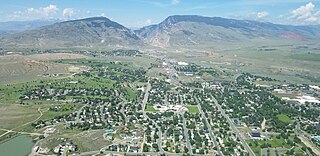
Cody is a city in Northwest Wyoming and the seat of government of Park County, Wyoming, United States. It is named after Buffalo Bill Cody for his part in the founding of Cody in 1896.
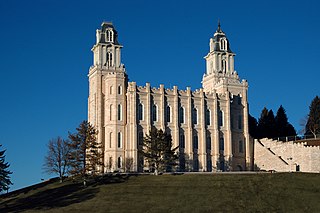
The Manti Utah Temple is the fifth constructed temple of the Church of Jesus Christ of Latter-day Saints. Located in the city of Manti, Utah, it was the third Latter-day Saint temple built west of the Mississippi River, after the Mormons' trek westward. The Manti Temple was designed by William Harrison Folsom, who moved to Manti while the temple was under construction. The temple dominates the Sanpete Valley, and can be seen from many miles. Like all Latter-day Saint temples, only church members in good standing may enter. It is one of only two remaining Latter-day Saint temples in the world where live actors are used in the endowment ceremonies ; all other temples use films in the presentation of the endowment, a practice that will end following renovations announced in 2021. It is an early pioneering example of four rooms representing the journey of life.

Carl Christian Anton Christensen was a Danish-American artist who is known for his paintings illustrating the history of the Church of Jesus Christ of Latter-day Saints. Of him it has been said that he "did more than any other person to capture the images of the history of Mormon migration to Utah and the life lived there".
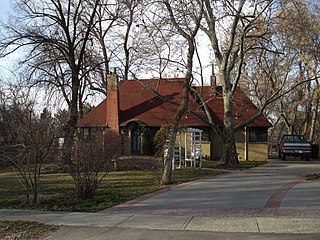
LeConte Stewart was a Latter-day Saint artist primarily known for his landscapes of rural Utah. His media included oils, watercolors, pastel and charcoal, as well as etchings, linocuts, and lithographs. His home/studio in Kaysville, Utah is on the National Register of Historic Places.

Minerva Bernetta Kohlhepp Teichert was a 20th-century American painter notable for her art depicting Western and Mormon subjects, including a collection of murals depicting scenes from the Book of Mormon. Teichert received her art education from the Art Institute of Chicago and the Art Students League of New York. Teichert was a member of the Church of Jesus Christ of Latter-day Saints. Other religious-themed artwork she is known for include Christ in a Red Robe, Queen Esther, and Rescue of the Lost Lamb. Additionally, Teichert painted 42 murals related to stories in the Book of Mormon which reside in Brigham Young University's (BYU) Museum of Art. She was the first woman invited to paint a mural for an LDS Church temple.

Richard Ballantyne was the founder of the Sunday School of the Church of Jesus Christ of Latter-day Saints, having begun the program in December 1849. He was also a Mormon pioneer and missionary.
Joseph Harry Anderson was an American illustrator and a member of the Illustrator's Hall of Fame. A devout Seventh-day Adventist artist, he is best known for Christian-themed illustrations he painted for the Adventist church and the Church of Jesus Christ of Latter-day Saints. He was also a popular illustrator of short stories in American weekly magazines during the 1930s and early 1940s.
Charles William Kingston was a member of the Latter Day Church of Christ and the Davis County Cooperative Society.
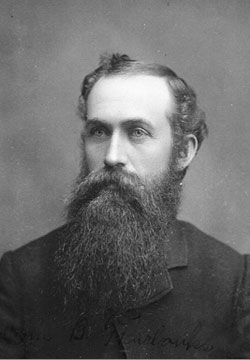
John B. Fairbanks was an American landscape painter. In 1890, he was one of a group of artists who studied in Paris under the sponsorship of the Church of Jesus Christ of Latter-day Saints, in preparation for painting murals at the nearly completed Salt Lake Temple. He painted murals in the Salt Lake Temple and the Mesa Arizona Temple that still exist today. Fairbanks was the official photographer for the South American expeditions of Benjamin Cluff. Fairbanks was the first artist to live and paint in Zion National Park. He was an early art instructor at Brigham Young Academy and was one of the founding members of the Utah Art Institute. Fairbanks was the father of sculptor Avard Fairbanks.

The Church of Jesus Christ of Latter-day Saints in Wyoming refers to the Church of Jesus Christ of Latter-day Saints and its members in Wyoming. The church's first congregation in Wyoming was organized in 1877. It has since grown to 67,797 members in 172 congregations.

The Sanctuary of Atotonilco is a church complex and part of a World Heritage Site, designated along with nearby San Miguel de Allende, Guanajuato, Mexico. The complex was built in the 18th century by Father Luis Felipe Neri de Alfaro, who, according to tradition, was called upon by a vision of Jesus with a crown of thorns on his head with blood on his face and carrying a cross. The main feature of the complex is the rich Mexican Baroque mural work that adorns the main nave and chapels. This was chiefly the work of Antonio Martínez de Pocasangre over a period of thirty years. The mural work has led the complex to be dubbed the "Sistine Chapel of Mexico." The complex remains a place of worship and penance to this day, attracting as many as 5,000 visitors every week.
Glenn E. Nielson was the founder of Husky Refining Company, now Husky Energy. He was nicknamed "Mr. Asphalt" because of his efforts to expand the use of asphalt in roads.
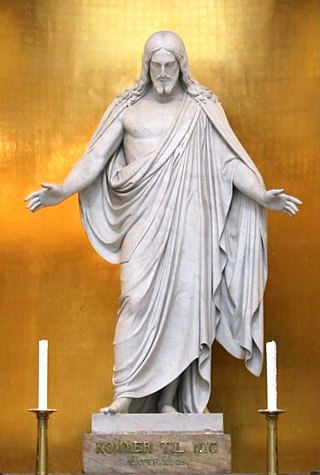
Christus is an 1833 white Carrara marble statue of the resurrected Jesus Christ by Bertel Thorvaldsen located in the Church of Our Lady in Copenhagen, Denmark. It was commissioned as part of a larger group, which includes 11 of the original 12 apostles and Paul the Apostle. It has been widely reproduced. Images and replicas of the statue were adopted by the leaders of the Church of Jesus Christ of Latter-day Saints in the 20th century to emphasize the centrality of Jesus Christ in its teachings.

The Church of Jesus Christ of Latter-day Saints in Illinois refers to the Church of Jesus Christ of Latter-day Saints and its members in Illinois. The official church membership as a percentage of general population was 0.44% in 2014. According to the 2014 Pew Forum on Religion & Public Life survey, less than 1% of Illinoisans self-identify themselves most closely with The Church of Jesus Christ of Latter-day Saints. The LDS Church is the 13th largest denomination in Illinois.

The Church of Jesus Christ of Latter-day Saints in Montana refers to the Church of Jesus Christ of Latter-day Saints and its members in Montana. The church's first congregation in Montana was organized in 1895. It has since grown to 51,715 members in 129 congregations.

Three missionaries of the Church of Jesus Christ of Latter-day Saints started proselyting to white English-speaking people in Cape Town in 1853. Most converts from this time emigrated to the United States. The mission was closed in 1865, but reopened in 1903.The South African government limited the amount of missionaries allowed to enter the country in 1921 and in 1955. Starting around 1930, a man had to trace his genealogy out of Africa to be eligible for the priesthood, since black people were not permitted to be ordained. In 1954 when church president David O. McKay visited South Africa, he removed the requirement for genealogical research for a man to be ordained, stipulating only that "there is no evidence of his having Negro blood in his veins".

The Church of Jesus Christ of Latter-day Saints in Wales refers to the Church of Jesus Christ of Latter-day Saints and its members in Wales.
Edward T. Grigware was an American painter. He painted murals for the Church of Jesus Christ of Latter-day Saints as well as for banks.
A visitors' center is a building often near a temple of the Church of Jesus Christ of Latter-day Saints where missionaries teach visitors about the tenets of their faith and other community events are held. Visitors' centers often include a replica of Bertel Thorvaldsen's Christus statue, exhibits, musical performances, devotionals, and a Family History Center.














